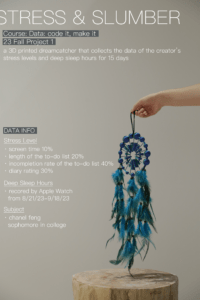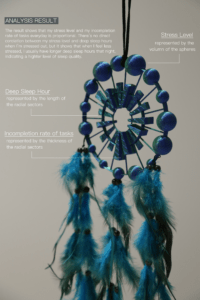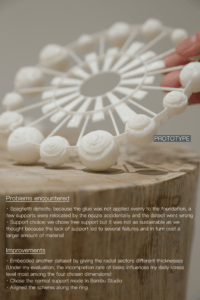My project1 is a dreamcatcher that collects the data of my stress levels and deep sleep hours per day for 15 days since the start of this semester and I named it “Stress and Slumber”. I was trying to explore how my sleep quality is affected by my stress level in the daytime, in an attempt to inform the audience that keeping their stress levels in a reasonable amount is essential to a good night’s sleep. It is also the reason why I chose dreamcatcher as my object. Dreamcatchers were born from the hands of Native Americans, who believed that dreamcatchers could protect sleepers, especially children, from bad dreams, nightmares, and evil spirits. I want people to relate to something nice like sweet dreams and a good, deep sleep when they see the object, and the part that shows my stress levels can serve as a reminder of not stressing themselves out.
To begin with the project, I first settled down my hypothesis:
“my sleep quality is affected by my stress level in the daytime”
For my sleep quality, I decided to use my smart watch to monitor my deep sleep hours, which is a parameter that can best represent the quality of sleep among all the sleep parameters. For my stress level, I used four dimensions to calculate. (1) screen time; (2) the length of my to-do list; (3)the incompletion rate of my to-do list; (4) rating my diary on a scale of 1 to 10. The fourth dimension is comparatively subjective, yet I believe it is important to embed a subjective dimension when calculating something subjective like stress level. I learned from the feminist data visualization podcast from last week’s assignment that data doesn’t always speak for itself. If there is no human intervention and research, the data might even show a result in reverse of the fact. I gave each of the dimensions a proportion and calculated my stress level everyday.
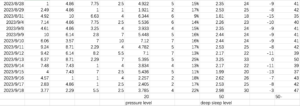
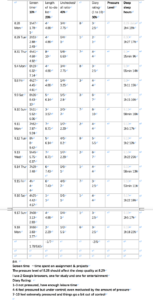
Before embedding the data to the object, I did some research on the shape of dreamcatchers. Since the upper part is always round, I decided that the data should be visualized within a circle and the lower part can be represented by feathers bought online since the project doesn’t require everything to be 3D printed. The stress level felt more like bubbles in my mind, and the deep sleep hours were more like a timeline and should be represented by shaped like lines. Thus, I decided that the stress levels can be an array of spheres that form a circle and the deep sleep hours can be radial sectors that point out to the stress level I felt that day. In Rhino, I used the array polar and offset functions to create the main visual based on the advice of Marcela. To make the data show things in a clearer way, I also scaled up the datasets several times so that the differences between each day became more obvious.
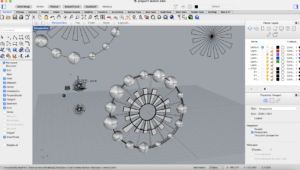
When I eventually finalized my sketch on Rhino and went to 3D printing, I did encounter a few major problems. The first one was that the dreamcatcher didn’t have a flat undersurface, which needed glue to fix. However, because the glue was not applied evenly to the foundation, a few supports were relocated by the nozzle accidentally and the detect went wrong so I had to glue several hemispheres back after the printing was done. Worse still, we chose tree support but it was not as sustainable as we thought because the lack of support led to several failures and in turn cost a larger amount of material. Learning the lesson from the first iteration, I put more glue on the foundation and adjusted the support mode for the second iteration. The fab lab assistant Freddie also figured out that my spheres, since adjusted to different sizes, were not aligned to the ring very well. So I adjusted that part as well. The second iteration came out much better. My classmate Lisa suggested that I could embed a third dataset, like changing the radial sectors to different thicknesses. Freddie also thought it was a good idea since in this way, the foundation would be more like a flat, which was easier for removing the support. Therefore, I embedded my incompletion rate of tasks as my third dataset into the object in my third iteration.
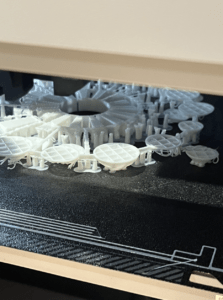
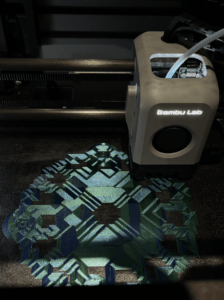
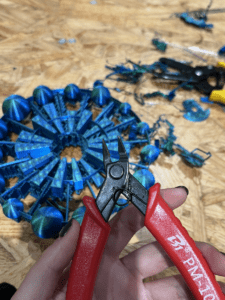
I chose the gradient green and blue material (PLA silk) in my third iteration, as the feathers that I bought was also in cold-tone colors. I find green and blue suitable to represent something peaceful and related to sleep quality.
The result of my data collection and analysis shows that my stress level and my incompletion rate of tasks is to a large extent proportional, meaning that whenever my incompletion rate goes up, my stress level increases. There’s no direct correlation between my stress level and deep sleep hours when I’m stressed out (also can be considered that my sleep is in chaos on stressful days), but it shows that when I feel less stressed, I usually have longer deep sleep hours that night, indicating a higher level of sleep quality.
Overall, it is my first experience with 3D printing and the project is personally meaningful. I had the chance to explore my stress and sleep in a more systematic way and visualize the result by creating something enlightening and visually appealing. I would like to thank the fab lab assistant here since he assisted me with my project devotedly and one day we worked till midnight since my object required 4 hours of printing each time and we encountered a few failures. I very much look forward to the next project.
